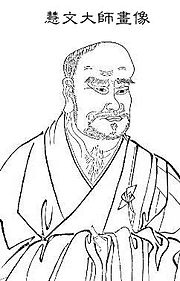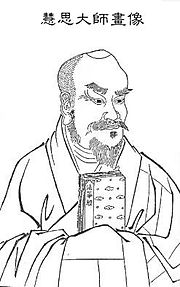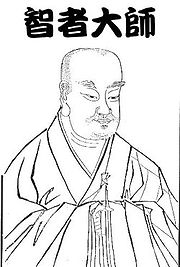Tiantai zong
The Buddhist school of Tiantai zong ( Chinese 天台 宗 , Pinyin Tiāntái zōng , W.-G. T'ien-t'ai tsung ; also "School of the Lotos Sutra ") was one of the most important Mahayana schools in East Asian Buddhism .
history
The first founder is Huiwen (550–577; 慧 文 , Huìwén , Hui-wen ), who wanted to attain enlightenment by blindly opening a blindly selected text. He came across verse XXIV: 18 of the Madhyamaka-śāstra ( 中 論 , Zhōnglùn , Chung-lun ):
"We note: All rise as a function is,
is emptiness / insubstantiality .
This is convention / conventional term.
That itself is the middle way . "
Huiwen's student Huisi (515–577; 慧思 , Huìsī , Hui-ssu ) took this discovery as an opportunity to develop the doctrine of the threefold truth of insubstantiality, conventionality and center .
The actual founder is Huisi's student Zhi Yi (538–597; 智 顗 , Zhìyǐ , Chih-i ), who fixed the teaching in the basic text Great Trilogy of the Tiantai School and thus made it known. He is understood in the representation of the Tiantai zong as their fourth patriarch.
The name of the Tiantai zong is derived from the mountain Tiantai in the mountains south of Shanghai. The original monastery of the tradition, of which Zhi-yi was the first abbot, stands on the Tiantai.
Patriarchs
The nine patriarchs of the Tiantai ( 天台 九 神 , tiāntáijiǔshén ) include:
- Nāgārjuna ( 龍樹 , Lóngshù , Long-shu );
- Huiwen from the Northern Qi Dynasty (550– ?; 慧 文 , Huìwén , Hui-wen , also 慧 聞 );
- Huisi (514 / 5–577; 慧思 , Huìsī , Hui-ssu );
- Zhiyi (538–597; 智 顗 , Zhìyǐ , Chih-i , also 智者 , zhìzhě , chih-che , also T'ien-t'ai );
- Guanding (561-632; 灌頂 , Guàndǐng , Kuan-ting );
- Fahua ( 法 華 , Fǎhuā , Fa-hua );
- Tiangung ( 天宮 , Tiāngōng , T'ien-kung );
- Zuoxi ( 左 溪 );
- Zhanran (711–782 / 4; 湛然 , Zhànrán , Chan-jan , also Jingqi 荆溪 , Jīngqī , Ching-ch'i , also 荊溪 )
Sometimes ten patriarchs are counted, with Daosui (8th to 9th centuries; 道 邃 ) listed above . Daosui was a teacher of Saichō and thus indirectly responsible for his propagation of the Tiantai belief as Tendai-shū in the early 9th century in Japan.
Teaching and scriptures
The teaching of the Tiantai zong is based on scriptures that come from both the Theravada tradition and the Mahayana . The three main sutras are the so-called Fahua sanbu jing ( 法 華 三 部 經 , fǎhuá sānbù jīng , fa-hua san-pu ching ) and also belong to the main sutras of Nichiren Buddhism :
- Wuliangyi jing ( 無量 義 經 , Wúliángyì jīng , Wu-liang-i ching - "Amitartha-sūtra, Sutra of Immeasurable Meanings", an introductory reading to the Lotus Sutra)
- Fahua jing ( 法華經 , Fǎhuá jīng , Fa-hua ching - "Lotus Sutra")
- Puxian guan jing ( 普賢 觀 經 , Pǔxián guān jīng , P'u-hsien kuan ching , a final reading; full title: 觀 普賢 菩薩 行 法 經 , Guān pǔxiánpúsà xíngfǎ jīng , Kuan p'u-hsien p'u -sa hsing-fa ching )
literature
- Margareta von Borsig (ex.): Lotos Sutra - The great book of enlightenment in Buddhism. Herder Verlag, new edition 2009. ISBN 978-3-451-30156-8
- Katō Bunno, Tamura Yoshirō, Miyasaka Kōjirō (tr.), The Threefold Lotus Sutra: The Sutra of Innumerable Meanings; The Sutra of the Lotus Flower of the Wonderful Law; The Sutra of Meditation on the Bodhisattva Universal Virtue , Weatherhill & Kōsei Publishing, New York & Tōkyō 1975 (Rissho Kosaikai) PDF (1.4 MB)
- Chen, Jinhua (1999). Making and Remaking History: A Study of Tiantai Sectarian Historiography. Tokyo: International Institute for Buddhist Studies. ISBN 4906267432
- Donner, Neal (1991). Sudden and Gradual Intimately Conjoined: Chih-i's Tíen-t'ai View. In: Peter N. Gregory (editor) (1991), Sudden and Gradual. Approaches to Enlightenment in Chinese Thought, Delhi Motilal Banarsidass
- Paul Magnin: La vie et l'oeuvre de huisi (515-577). (Les origines de la secte bouddhique chinoise du Tiantai.) Publications de l'École Française d'Extrême-Orient, Vol.CXVI, Paris, École Française d'Extrême-Orient, 1979.
- Paul L. Swanson, Foundations of T'ien-T'ai Philosophy, Asian Humanities Press, California, 1989. ISBN 0-89581-919-8 .
- Donner, Neal & Daniel B. Stevenson (1993). The Great Calming and Contemplation . Honolulu: University of Hawai'i Press.
- Hurvitz, Leon (1962). Chih-i (538-597): An Introduction to the Life and Ideas of a Chinese Buddhist Monk . Mélanges Chinois et Couddhiques XII, Bruxelles: Institut Belge des Hautes Études Chinoises.
- Wu, Ju-chün (1993). T'ien-T'ai Buddhism and early Mādhyamika, Honolulu, Hawaii, University of Hawaii Press, ISBN 0-8248-1561-0
- Petzold, Bruno (1982). The quintessence of the T'ien-T'ai (Tendai) teaching. A comparative study. Wiesbaden: Otto Harrassowitz, ISBN 3447021616
- Ziporyn, Brook (2004). Tiantai School, in Robert E. Buswell, ed., Encyclopedia of Buddhism, New York, McMillan. ISBN 0-02-865910-4
Web links
- Buddhism of T'ien-T'ai Peter Johnson: partial translation of some works by Chi-I (accessed August 7, 2013)
- Kai Krause, Buddhist Tradition in China: The System of the Tiantai School ( Memento from September 6, 2015 in the Internet Archive ), Numata Center, University of Hamburg



